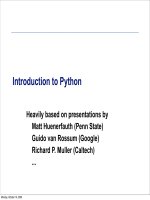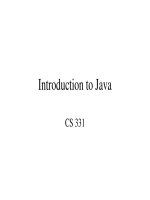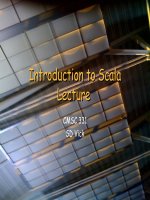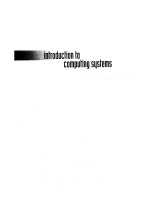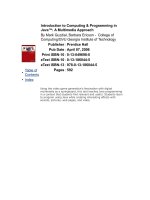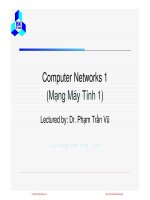Introduction to Computing: Lecture 3 - Dr. Pham Tran Vu
Bạn đang xem bản rút gọn của tài liệu. Xem và tải ngay bản đầy đủ của tài liệu tại đây (554.41 KB, 28 trang )
Introduction to Computing
Lectured by: Dr. Pham Tran Vu
1
Computer Hardware
Computer Systems
Computer Architecture
Input and Output Devices
Storage Systems
2
Computer Systems
Functional components of a computer
system
Input
Main memory
Central Processing Unit (CPU)
Output
Backing storage
Peripheral devices
3
Input
Take in data for processing by the computer
Convert real-world data into a machine
sensible format
Examples: Keyboard, webcam, microphone
4
Main Memory
Commonly known as RAM (Random Access
Memory)
Two main functions
To temporarily store programs currently in use for
processing data
To temporarily store data
Entered through input devices
Currently being processing
Resulted from processing
5
CPU
Often referred to as the processor
Has two elements
Arithmetic/Logic unit (ALU): perform arithmetic
operations, e.g. addition, multiplication, etc.
Control unit: control the operations of all
hardware, including input and output devices,
and the CPU
6
Output
Translate machine sensible data into human
readable form
Examples: Screens, printers, speakers
7
Backing Storage
Performs a filing function within the
computer system
Important concepts:
Memory volatility: data will disappear when the
power is switched off, e.g. RAM
Retrieval data: for permanent storage of
programs and data files
8
Peripherals
Peripherals are devices that are external to
CPU and main memory
e.g. input and output devices, storage
devices, etc.
9
Classification of Computer Systems
Main frame computers
Minicomputers
Microcomputers
Portable computers
Pen-based computers
10
Computer Architecture
Three basic components
Memory
Processor
Buses
11
Memory - RAM
The working area of a computer
Store programs and data currently in use
Measured in Kb, Mb or Gb
Volatile
Directly accessed by the CPU
Types of RAM
SRAM, DRAM, EDO RAM, SDRAM, DDR SDRAM
12
Cache Memory
Located between CPU and RAM
Hold copy of frequently used code and data
Fast in speed but small in size
Used to improve memory access times
RAM
CPU
Cache
(SRAM and
Control logic)
13
Memory - ROM
Read Only Memory
Non-volatile
Data in ROM cannot be changed by
software
Used in BIOS (Basic Input/Output System)
CD-ROM
14
Processor
The centre of machine power
Control all the activities of the system
Registers
Registers used in the fetch-execute cycle
Index registers: used to hold offset values or
counters
Stack pointer register
Flag or status register
15
CPU Clock Speed
Determine how quickly a processor can
execute instructions
Steps to execute a program (a set of
instructions)
Fetch -> Decoding -> Execute
Processor activity must be synchronised
with clock cycle
16
Processor Architecture
A processor consists of a complex collection of
component units: registers, counters, arithmetic
and logic circuits and memory elements
All instructions available with a processor is called
instruction set
Two main approaches to computer design:
CISC: Complex Instruction Set Computer
RISC: Reduced Instruction Set Computer
17
CISC Architecture
Longer memory word length should be used
to create more complex instruction sets for
more powerful processors
Instructions are different in length
Instruction execution times are also different
18
RISC Architecture
Provide only a small number of different
instructions
Each instruction type can be executed in only one
clock pulse
More complex instructions can take several clock
pulses
Super scalar execution: can execute more than
one instruction at a time
Integral cache memory and branch prediction
19
Parallel Processing Architecture
Pipelining
Processor arrays
SIMD- Single Instruction Multiple Data
MIMD – Multiple Instruction Multiple Data
Parallel processing applications:
Weather forecast, image processing, scientific
simulations, etc.
20
Buses
For communications between parts of the computer
system
A bus is a group of parallel wires, one for each bit of
a word
The system bus connect a computer’s processor and
its associated components of memory, I/O devices
A computer usually has several buses
The width of a bus determines the length of the word
can be handled at one time
Some buses are bi-directional
21
Input and Output Devices (1)
Input devices
Keyboard
Mouse
Tracker ball
Touch screen
Digitising tablet
Light pen
Scanners
22
Input and Output Devices
Output devices
Visual display unit
Dumb and intelligent terminals
Text and graphics modes
Text mode and dot matrix characters
Screen resolution and size
Printers
Speakers
23
Dot Matrix Display
8
8
size
8x8
14x8
16x8
24
Printers
Dot matrix printer
Inkjet printer
Laser printer
25

